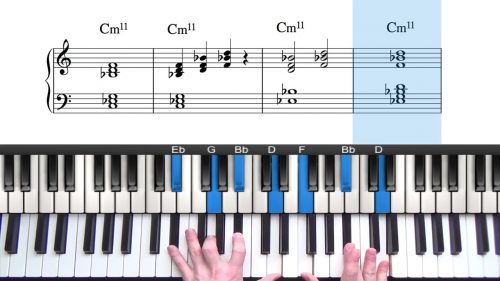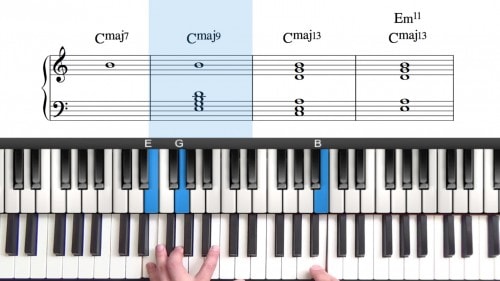Major Chord Voicings Tutorial
One of the challenges of playing jazz is being able to quickly find a voicing that works well underneath any melody note you could come across on a lead sheet.
When you are playing, you should always be consciously analysing the melody note in terms of what scale degree it is in relation to the chord underneath.
If you have memorised a range of voicings that you know work well under specific scale degrees you will be able to easily find a suitable voicings to play under any melody note you come across.
Building chords that connects the harmony to the melody in this way is called harmonising the melody and when this can be done quickly, you’re playing will begin to sound much fuller.
In this lesson I am going to explore a range of major voicings that can be used under each of the 7 notes of the Lydian mode.
Lesson Downloads
-
Major Voicings Lesson Supplement File Type: pdf
-
Major Voicings Lesson Transcript File Type: pdf
Practice Tips
The key is to memorise these voicings is to remember the formulas in terms of scale degrees.
If you like the sound of one of the voicings... for example - a major chord with the #11th in the melody - immediately apply it to jazz standards
Open your fake book, or flick through the jazz standards you have learnt and look out for a major chord with the #11 in the melody.
When you find one, try your voicing, you will likely have to work out the notes using the scale degree formula. Perhaps starting with the root at the bottom and working up.
By doing this you will retain the shape and the information much better…. because you have taken the time to work it out.
Keep looking through your fake book, or through your jazz standards until you have built the same voicing in a few different keys… the more keys you build it in, the deeper your understand will become.
By simply running the voicing through all 12 keys, you will have difficulty remembering all of the shapes, and also applying them in context of actual tunes (which is the end goal!)








Hey could you recommend the best way to learn these voicings across all 12 keys?
Hey Bien,
Yes sure… here is some important information for memorising voicings:
Every time I come across a chord on a lead sheet, I analyse the scale degree of the melody in relation to the chord underneath. I have got to a point where i do not need to think about this, I see the melody note and my hands just go for the voicing.
For example, if you see a major chord on a lead sheet, it may be the #11th in the melody, in which case, you should immediately think that the Kenny Barron Major Voicings could be a good choice of voicing (or any of the voicings from this lesson that have the #11 in the melody).
You should always make this conscious analysis of the scale degree of the melody when you are playing through jazz standards and it will help you memorise and internalise voicings. This is really important.
By ‘internalise’ I mean remember the formula. With jazz it is far more efficient to think in terms of numbers (or scale degrees) than to think of individual notes. So for example, with the So What Chord, from top to bottom, it contains the Root. 11th, b7th, b3rd and 5th. Knowing this formula means you can then apply it to any key (considering you know your major and minor scales!)
Above anything else, practice in context of jazz standards and always analyse what you are playing in terms of the scale degrees. Experiment with different voicings and when you find something that works, make a mental note of it and play the voicing in a few different keys so that you remember the construction in terms of scale degrees.
I help this helps answer your question?
Let me know if you would like me to elaborate on anything :-)
Cheers,
Hayden
Dear Hayden,
Really lovely lessons. So question is, if I want to practice a certain jazz standard tune and i mean the full song – where do we get them? or are the actual full scores for each song already available in the downloads area? or a separate section where we buy the scores or book? Thanks very much! and one more thing please – how do I know if you have already responded to this question? without needing to get notified of all the other future comments for example in this thread? Many thanks in advance.
Hey Tina,
All of our jazz standard lessons can be found in 2 places:
– Jazz Standards By Genre: pianogroove.com/jazz-standards/
– Jazz Standards By Difficulty: pianogroove.com/jazz-standard-index-difficulty/
And regarding the comments, you will just be notified of replies to your question, and not all replies to any question posted.
Cheers,
Hayden
Hi Hayden,
On the major voicing options worksheet, 9th in the melody F6/9, the left hand is playing the major 7th (E), in this case, the chord will still be indicated as F6/9 or it should become Fmaj13 ( but the 11th is missing). Sorry I know it is kind of strange kind of question but I am still trying to get familiar with what notes to play when I see the chord names.
Another question is I found myself progressing very very slowly!! Any tip on practicing daily? Let’s say I only have half an hour every night?
Thanks!!!
Hi Erica,
Apologies for the late reply here.
On the major voicing options worksheet, 9th in the melody F6/9, the left hand is playing the major 7th (E), in this case, the chord will still be indicated as F6/9 or it should become Fmaj13 ( but the 11th is missing).
Yes if both D and E are included in the chord, this would be Fmaj13. The rule to remember is that if the 7th is present in the chord, the 6th will become the 13th, as it is added in addition to the 7th, rather than replacing it.
I will correct the PDF download to make this clearer and apologies for the confusion.
Regarding the 11th, it doesn’t need to be present for it to be a 13th chord, we name chords by their highest extension and so we can have a major 13th chord which doesn’t contain the 11th. The same is true for dominant chords. For major and dominant chords, it’s very common for them to contain the 9th and 13th, and omit the 11th.
Another question is I found myself progressing very very slowly!! Any tip on practicing daily? Let’s say I only have half an hour every night? Thanks!!!
Yes please see this PDF with what I recommend as the ‘essential drills and exercises’ for beginner/early intermediate jazz studies:
pianogroove.com/media/2024/02/Beginner-Jazz-Piano-Roadmap.pdf
I’d recommend to alternate these drills each on different days, working up to completing the drills in 12 keys in one 15 minute practice session, but breaking them down into smaller groups of keys to start if needed.
4 x 15 minute chunks of time allows us to focus on 4 areas each day and gives us enough time to get stuck into the drills and force the repetition needed to internalise these chords and progressions.
When starting out with jazz theory, I personally found 1 hour in the morning was optimal for theory drills and exercises like in the PDF above, and then in the evening I would spend as much time as possible learning and playing jazz standards – I found that to be a great combination.
Ultimately there is a lot of theory to learn and so it is a gradual process. This is why I recommend to balance theory with learning jazz standards which is the more enjoyable and rewarding side of learning jazz piano whilst we chipping away at the theory.
My main recommendation is to aim for 1 hour minimum per day and follow the guidance above.
I hope that helps Erica – if you have any other questions just let me know.
Best,
Hayden